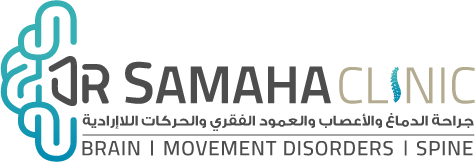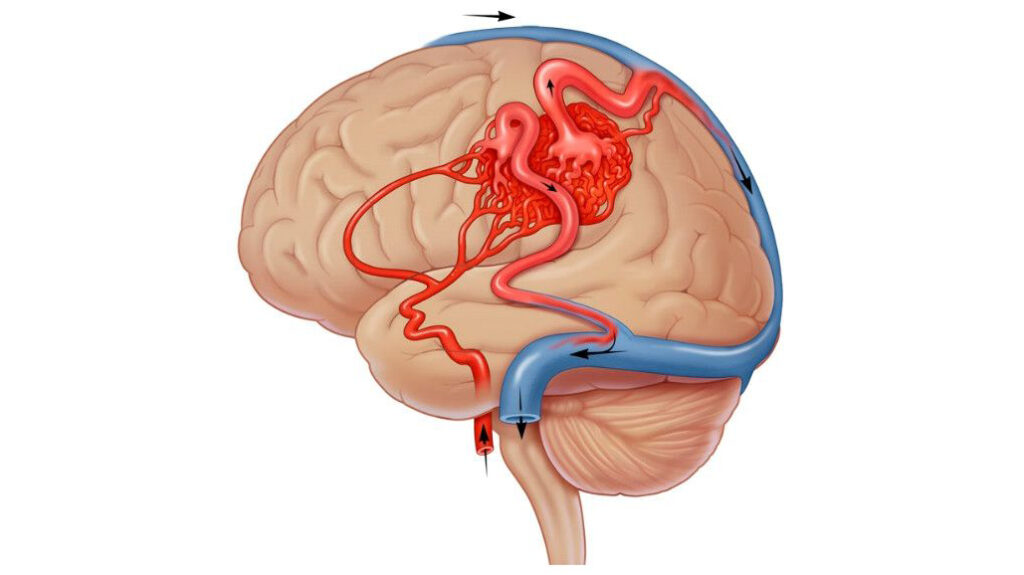الاتصال الشرياني الوريدي الخلقي هو عيب خلقي بالأوعية الدموية الدماغية أثناء التخليق داخل رحم الأم، وهو ليس وراثياً وإنما عيباً خلقياً كما يسمى. ويعرّف المرض بأنه اتصال مباشر ما بين الشريان والوريد وإن التدفق الدموي من الشريان لا يذهب الى فروعه والشعيرات الدموية الدقيقة المتفرعة عنه لتغذية الأنسجة الدماغية، بل يتدفق مباشره الى الوريد الذي يعيده الى القلب دون الاستفادة منه وقد يعيش الانسان مع هذا المرض طبيعياً ودون أية أعراض، ولذا فإننا قد نكتشفه عند تصوير الدماغ لأسباب أخرى مثلاً عند حدوث إصابة للرأس واستدعت الحالة الى التصوير الطبقي أو التصوير بالمرنان المغناطيسي للدماغ.
وعند حدوث أعراض المرض فإنها تنشأ عن نزف من الاتصال الشرياني الوريدي الدماغي الخلقي داخل الدماغ، ومن هذه الأعراض الصداع المفاجئ، أو نوبات الصرع المفاجئة، أو أية أعراض عصبيه تنشأ نتيجة تعطل أو تضرر أجزاء الدماغ المسؤولة عن تلك الأعراض.
وتبلغ نسبة النزف السنوية من الاتصال الشرياني الوريدي حوالي 1 %، وتزداد الى 5 % كل عام بعد حدوث النزف الأول.
وفي حال حدوث نزف كبير بالدماغ فإنه قد يؤدي الى شلل نصفي أو الموت المفاجئ للمريض وخاصة بسن المراهقة. نقوم بتشخيص الاتصال الشرياني الوريدي بعد اخذ السيرة المرضية للمريض، والتصوير الطبقي المحوري، والتصوير بالمرنان المغناطيسي للدماغ والتصوير المغناطيسي الشرياني للدماغ. والتشخيص المؤكد يأتي بإجراء التصوير الشرياني الدماغي بالقسطرة الشريانية الدماغية
علاج الاتصال الشرياني الدماغي الخلقي
- المراقبة: وذلك عند اكتشاف المرض بمحض الصدفة أو وجود اتصال شرياني وريدي كبير بمنطقة كبيره بالدماغ
- الجراحة المجهرية الدماغية لاستئصال الاتصال الشرياني الوريدي الخلقي
ونوصي بهذه الطريقة عند حدوث النزف من اتصال شرياني وريدي بمنطقة أمام الفص الجبهي أو أمام الفص الصدغي أو مؤخرة الفص الخلفي، شرط أن يكون المريض بصحه جيده ويحتمل التخدير العام - تجليط الاتصال الشرياني الوريدي بماده غرويه
تحقن بالشريان المغذي للاتصال الشرياني الوريدي عن طريق القسطرة. ونسبة نجاح هذه الطريقة بإغلاق الاتصال الشرياني الوريدي تقل مع ازياد حجم الاتصال الشرياني الوريدي أو مكان تواجده وخاصه داخل عمق الدماغ. وتبلغ المضاعفات المتوقعة حوالي 10 % وذلك بإحداث أعراض عصبيه رئيسيه نتيجة ذلك - الجراحة الشعاعية المصوبة بالجاما نايف (بدون جراحه)
تعتبر هذه التكنولوجيا هي الأحدث لعلاج أمراض وأورام الدماغ بدون جراحه، وبدون جروح وبدون تخدير وبدون اقامه بالمستشفى وبدون مضاعفات الجراحة المجرية وبدون سقوط الشعر، وبجلسه واحده يستطيع المريض بعدها مغادره المستشفى بنفس يوم المعالجة.
وتتم هذه التقنية بواسطة تثبيت جهاز الجراحة المصوبة الثلاثية الأبعاد (الستيريوتاكتيك) على رأس المريض باستخدام التخدير الموضعي، وبإجراء تصوير بالمرنان المغناطيسي الثلاثي الأبعاد والقسطرة الشريانية الثلاثية الأبعاد لتحديد حدود وحجم واحداثيات بؤرة الاتصال الشرياني الوريدي داخل الدماغ.
وبعد ذلك يوضع المريض على سرير جهاز الجاما نايف ونوجه اشعة الجاما الموجه من (201) أنبوبه شعاعيه الى بؤرة الاتصال الشرياني الوريدي داخل الدماغ والمريض بكامل وعيه وبدون ألم وبدقه متناهيه لاتصل نسبة الخطأ لأكثر من 0.25 ملم.
وبعد الانتهاء من إعطاء الجرعة الشعاعية نقوم بإزالة جهاز الستيريوتاكتيك عن رأس المريض والذي بإمكانه مغادرة المستشفى بنفس يوم المعالجة والعودة لحياته المعتادة باليوم التالي.
تصل نسبة النجاح بإغلاق الاتصال الشرياني الوريدي 80 – 95 % خلال السنوات الثلاث التي تلي المعالجة وهذا يعتمد على حجم بؤرة المعالجة بحيث كلما كانت البؤرة صغيره، تكون الجرعة الشعاعية العلاجية أكبر ونسبة النجاح بإغلاقها أكثر. ونسبة المضاعفات قليله وهذه تعتمد على حساسية المكان الذي يوجد به الاتصال الشرياني الوريدي الخلقي المعالج.
يعتبر الاتصال الشرياني الوريدي الدماغي من الامراض الدماغية الخلقية الخطيرة والتي تشكل خطورة كبيره في حال النزف داخل الدماغ.
هنالك نسبة 2% من الحالات تنزف كل عام مما يؤدي الى موت مفاجئ بالمريض او مضاعفات النزف والتلف الدماغي. العلاج الامثل لهذه الحالة هو الاستئصال الجراحي إذا أمكن مع احتساب تجنب المضاعفات الخطيرة. وهنالك 70% من الحالات يكون الاستئصال الجراحي لها خطرٍ ولذا فان العلاج البديل والأمثل هو بالجاما نايف بدون جراحه، وتصل نسبة النجاح بإغلاق الاتصال الشرياني خلال السنوات الثلاث التي تلي المعالجة من 85-95%. وفي حال الاغلاق الجزئي بعد مرور السنوات الثلاث، فانه بالإمكان اجراء معالجه اخرى بالجاما نايف للتمكن من الاغلاق التام للاتصال الشرياني الوريدي. وقد تم معالجة ما يفوق ثلاثمائة حاله بمركز عمان للجاما نايف.
وبالنسبة لطريقة اغلاق للاتصال الشرياني الوريدي بالقسطرة الشريانية الجليطية، فان نسبة النجاح قليله بالإغلاق التام للاتصال الشرياني الوريدي، ولذا فإنها تستعمل بمعظم الحالات كمرحله اولى للتحضير للجراحة او لمعالجه بالجاما نايف

